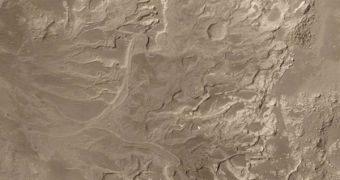A new set of observations, just recently received from NASA's Mars Reconnaissance Orbiter (MRO) probe currently moving above the Red Planet, have revealed a set of landscape features that hint at the fact that water flowed on the surface of our neighbor no longer than one billion years ago. Although that may seem like a long time, the features are more recent than any other similar finding on Mars, and may yield new models of what happened to all the liquid.
Scientists know that, as far as Mars' poles go, they are covered with ice, which resides only centimeters under a thin layer of dust and rock debris. The theory was confirmed by the Phoenix Mars Lander, which acquired the first samples on location, as it descended on the planet's surface. The probe also hinted at the fact that salts in the soils must have allowed the water to remain liquid at temperatures far lower than zero degrees Celsius.
The newly found features, some 800 foot (250 meter) wide and a few tens of miles long, bear a striking resemblance to valleys on our own planet, which had their shape carved out over millions of years, by flowing rivers. “We believe that these new valleys were formed within the last billion years, which is quite recent when you view it in the geologic history of water on Mars,” Jay Dickson, an astronomer from the Brown University, who has led the science team that has made the new find, told Space.
According to existing geological data, the last major precipitations occurred on the Red Planet more than 3.5 billion years ago. Apparently, they were pretty significant, as geologists infer that they generated the largest number of landscape features, which are only now beginning to be found. On account of the large volume of water that has at one point flowed on Mars' surface, astronomers believe that it couldn't simply have entirely vanished. Surely, the polar caps retain some of it, but remains could also exist under the surface, in underground briny lakes, kept fluid by a large concentration of salts, as well as by their proximity to the heat of the planet's core.
“Evidence for life might be better preserved in a younger terrain like what we have found, as opposed to the ancient terrain that was once wet, but has been significantly buried or eroded over 4 billion years. The interior of Lyot crater is an optimal micro-environment, since its low elevation leads to high surface pressure, and temperature conditions at its location in the northern mid-latitudes are sufficient for melting during periods of high-obliquity. This micro-environment in Lyot apparently allowed melting of surface ice and the formation of the youngest fluvial valley systems of this scale yet observed on Mars,” the BU experts wrote in a recent edition of the journal Geophysical Research Letters.

 14 DAY TRIAL //
14 DAY TRIAL //